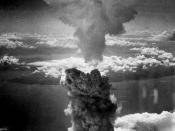On August 6, 1945, the Enola Gay, a United States B29 bomber, dropped the world's first atomic bomb. The bomb, made by enriching Uranium and nicknamed "Little Boy," destroyed a Japanese city and introduced the concept of nuclear war to the world (Farris 7; "Decision to Drop" 1). Although the dropping of the atomic bomb by the United States was necessary to end the war as soon as possible, there were also many repercussions that resulted. The atomic bombs had many consequences on people, communities, and countries after World War II. The dropping of the atomic bombs on Hiroshima and Nagasaki, Japan, were important and significant events in United States history.
In 1939, at the onset of World War II, Hiroshima had grown into the seventh largest city in Japan, with some estimates putting the civilian population at 280,000 to 290,000 during this time period (Ziff 71; Farris 13).
The Japanese also had a large military and the greedy desire to conquer territories. Making use of its military, Japan decided to attack the United States little before 8:00 AM on December 7, 1941. Japanese planes appeared in the skies above Pearl Harbor, Hawaii, a United States naval port, and began bombing Pearl Harbor relentlessly for hours, completely destroying the port and its ships (Ziff 37). Eight battleships were among the eighteen vessels sunk or severely damaged, more than 180 planes were destroyed, 2,403 servicemen were lost, and 1,178 servicemen were wounded (38).
President Roosevelt quickly met with Congress as well as other leaders of the Allied powers to discuss the situation. On December 8, 1941, President Roosevelt requested a declaration of war from Congress and it was overwhelmingly approved (Ziff 39). Roosevelt then met with Prime Minister Winston Churchill of Britain and the two nations declared war on...



Absolutely incredible essay
I can't find anything wrong with this essay. Excellent work and good bibliography. I give you 10/10
1 out of 1 people found this comment useful.